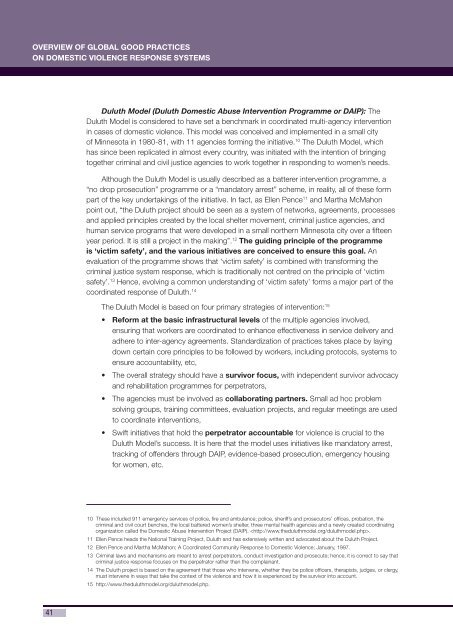Domestic Violence Legislation and its Implementation
Domestic Violence Legislation and its Implementation
Domestic Violence Legislation and its Implementation
You also want an ePaper? Increase the reach of your titles
YUMPU automatically turns print PDFs into web optimized ePapers that Google loves.
OVERVIEW OF GLOBAL GOOD PRACTICES<br />
ON DOMESTIC VIOLENCE RESPONSE SYSTEMS<br />
41<br />
Duluth Model (Duluth <strong>Domestic</strong> Abuse Intervention Programme or DAIP): The<br />
Duluth Model is considered to have set a benchmark in coordinated multi-agency intervention<br />
in cases of domestic violence. This model was conceived <strong>and</strong> implemented in a small city<br />
of Minnesota in 1980-81, with 11 agencies forming the initiative. 10 The Duluth Model, which<br />
has since been replicated in almost every country, was initiated with the intention of bringing<br />
together criminal <strong>and</strong> civil justice agencies to work together in responding to women’s needs.<br />
Although the Duluth Model is usually described as a batterer intervention programme, a<br />
“no drop prosecution” programme or a “m<strong>and</strong>atory arrest” scheme, in reality, all of these form<br />
part of the key undertakings of the initiative. In fact, as Ellen Pence 11 <strong>and</strong> Martha McMahon<br />
point out, “the Duluth project should be seen as a system of networks, agreements, processes<br />
<strong>and</strong> applied principles created by the local shelter movement, criminal justice agencies, <strong>and</strong><br />
human service programs that were developed in a small northern Minnesota city over a fi fteen<br />
year period. It is still a project in the making”. 12 The guiding principle of the programme<br />
is ‘victim safety’, <strong>and</strong> the various initiatives are conceived to ensure this goal. An<br />
evaluation of the programme shows that ‘victim safety’ is combined with transforming the<br />
criminal justice system response, which is traditionally not centred on the principle of ‘victim<br />
safety’. 13 Hence, evolving a common underst<strong>and</strong>ing of ‘victim safety’ forms a major part of the<br />
coordinated response of Duluth. 14<br />
The Duluth Model is based on four primary strategies of intervention: 15<br />
• Reform at the basic infrastructural levels of the multiple agencies involved,<br />
ensuring that workers are coordinated to enhance effectiveness in service delivery <strong>and</strong><br />
adhere to inter-agency agreements. St<strong>and</strong>ardization of practices takes place by laying<br />
down certain core principles to be followed by workers, including protocols, systems to<br />
ensure accountability, etc,<br />
• The overall strategy should have a survivor focus, with independent survivor advocacy<br />
<strong>and</strong> rehabilitation programmes for perpetrators,<br />
• The agencies must be involved as collaborating partners. Small ad hoc problem<br />
solving groups, training committees, evaluation projects, <strong>and</strong> regular meetings are used<br />
to coordinate interventions,<br />
• Swift initiatives that hold the perpetrator accountable for violence is crucial to the<br />
Duluth Model’s success. It is here that the model uses initiatives like m<strong>and</strong>atory arrest,<br />
tracking of offenders through DAIP, evidence-based prosecution, emergency housing<br />
for women, etc.<br />
10 These included 911 emergency services of police, fi re <strong>and</strong> ambulance; police, sheriff’s <strong>and</strong> prosecutors’ offi ces, probation, the<br />
criminal <strong>and</strong> civil court benches, the local battered women’s shelter, three mental health agencies <strong>and</strong> a newly created coordinating<br />
organization called the <strong>Domestic</strong> Abuse Intervention Project (DAIP). .<br />
11 Ellen Pence heads the National Training Project, Duluth <strong>and</strong> has extensively written <strong>and</strong> advocated about the Duluth Project.<br />
12 Ellen Pence <strong>and</strong> Martha McMahon; A Coordinated Community Response to <strong>Domestic</strong> <strong>Violence</strong>; January, 1997.<br />
13 Criminal laws <strong>and</strong> mechanisms are meant to arrest perpetrators, conduct investigation <strong>and</strong> prosecute; hence, it is correct to say that<br />
criminal justice response focuses on the perpetrator rather than the complainant.<br />
14 The Duluth project is based on the agreement that those who intervene, whether they be police offi cers, therapists, judges, or clergy,<br />
must intervene in ways that take the context of the violence <strong>and</strong> how it is experienced by the survivor into account.<br />
15 http://www.theduluthmodel.org/duluthmodel.php.

















